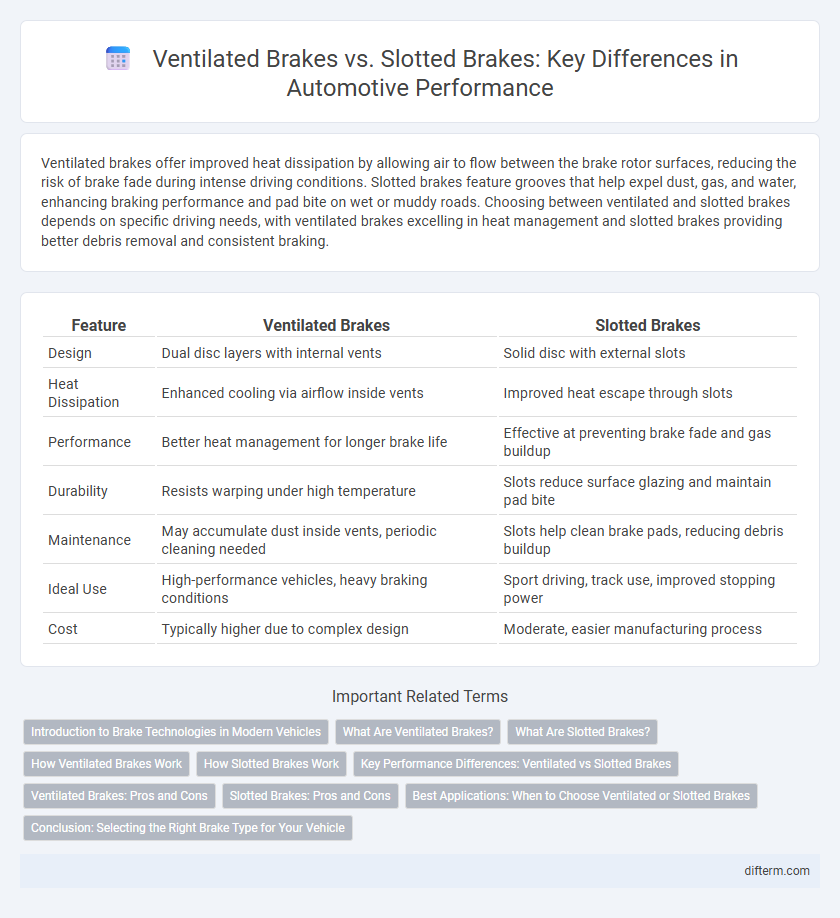Ventilated brakes offer improved heat dissipation by allowing air to flow between the brake rotor surfaces, reducing the risk of brake fade during intense driving conditions. Slotted brakes feature grooves that help expel dust, gas, and water, enhancing braking performance and pad bite on wet or muddy roads. Choosing between ventilated and slotted brakes depends on specific driving needs, with ventilated brakes excelling in heat management and slotted brakes providing better debris removal and consistent braking.
Table of Comparison
| Feature | Ventilated Brakes | Slotted Brakes |
|---|---|---|
| Design | Dual disc layers with internal vents | Solid disc with external slots |
| Heat Dissipation | Enhanced cooling via airflow inside vents | Improved heat escape through slots |
| Performance | Better heat management for longer brake life | Effective at preventing brake fade and gas buildup |
| Durability | Resists warping under high temperature | Slots reduce surface glazing and maintain pad bite |
| Maintenance | May accumulate dust inside vents, periodic cleaning needed | Slots help clean brake pads, reducing debris buildup |
| Ideal Use | High-performance vehicles, heavy braking conditions | Sport driving, track use, improved stopping power |
| Cost | Typically higher due to complex design | Moderate, easier manufacturing process |
Introduction to Brake Technologies in Modern Vehicles
Ventilated brakes feature internal vanes between the brake rotors designed to improve heat dissipation and reduce brake fade during high-performance driving. Slotted brakes incorporate grooves on the rotor surface that help channel dust, gas, and water away from the braking area, enhancing grip and rotor cooling. Both technologies play critical roles in modern vehicle safety by optimizing braking performance and durability under diverse driving conditions.
What Are Ventilated Brakes?
Ventilated brakes feature a design with two brake discs separated by a series of internal vanes that allow air to flow through, enhancing heat dissipation during braking. This airflow reduces the risk of brake fade by maintaining lower operating temperatures under heavy or prolonged braking conditions. Commonly used in performance and heavy-duty vehicles, ventilated brakes improve overall braking efficiency and durability compared to solid brake discs.
What Are Slotted Brakes?
Slotted brakes feature precision-cut grooves on the rotor surface, designed to improve heat dissipation and enhance braking performance under heavy use. These slots help eject gas, dust, and water from the brake pad surface, maintaining consistent friction and reducing brake fade during high-stress driving conditions. Slotted rotors are commonly used in performance and racing vehicles for their superior stopping power and heat management compared to standard rotors.
How Ventilated Brakes Work
Ventilated brakes enhance heat dissipation by incorporating internal vanes between two friction surfaces, allowing air to flow through the rotor and cool it efficiently during braking. This airflow reduces brake fade and improves overall performance under high-stress conditions. Compared to slotted brakes, ventilated rotors maintain lower temperatures, ensuring consistent stopping power and durability, especially in demanding automotive applications.
How Slotted Brakes Work
Slotted brakes enhance stopping performance by incorporating precisely engineered grooves on the disc surface, which help dissipate heat and channel away gases, dust, and water that accumulate during braking. This design promotes consistent friction between the brake pad and rotor, reducing brake fade and improving overall braking efficiency. By maintaining a cleaner contact surface, slotted brakes optimize braking power, especially in high-performance and demanding driving conditions.
Key Performance Differences: Ventilated vs Slotted Brakes
Ventilated brakes feature internal channels that improve heat dissipation, reducing the risk of brake fade during heavy use, which is critical for high-performance and heavy vehicles. Slotted brakes have grooves on the rotor surface that help expel gas, dust, and water, enhancing braking consistency and bite in wet or dusty conditions. Performance-wise, ventilated brakes excel in thermal management and prolonged braking, while slotted brakes offer superior initial braking response and debris clearance.
Ventilated Brakes: Pros and Cons
Ventilated brakes enhance heat dissipation through internal vanes between brake pads, reducing the risk of brake fade during high-performance driving or heavy loads. Their design improves cooling efficiency, leading to more consistent braking performance and extended rotor lifespan. However, ventilated brakes tend to be heavier and more complex, potentially increasing vehicle weight and maintenance costs compared to solid or slotted brake rotors.
Slotted Brakes: Pros and Cons
Slotted brakes enhance heat dissipation and improve braking performance by allowing gases and debris to escape from the brake pad surface, reducing the risk of brake fade under intense driving conditions. They offer better water dispersion on wet roads, maintaining consistent stopping power, but can cause increased rotor wear and noise compared to standard rotors. While slotted brakes provide superior initial bite and cooling, the trade-off includes potentially higher maintenance costs due to accelerated rotor degradation.
Best Applications: When to Choose Ventilated or Slotted Brakes
Ventilated brakes excel in high-performance vehicles and heavy-duty applications where heat dissipation is critical, preventing brake fade during extended use. Slotted brakes are ideal for aggressive driving and track conditions, as their slots help remove gas, dust, and water from the rotor surface, enhancing brake bite and consistency. Choosing ventilated or slotted brakes depends on balancing heat management needs with the driving environment and performance demands.
Conclusion: Selecting the Right Brake Type for Your Vehicle
Choosing between ventilated brakes and slotted brakes depends on your driving conditions and performance needs. Ventilated brakes excel in heat dissipation, making them ideal for heavy braking and high-speed driving, while slotted brakes enhance debris removal and maintain consistent friction during aggressive driving. Opting for the right brake type ensures optimal safety, improved braking performance, and extended component lifespan tailored to your vehicle's requirements.
ventilated brakes vs slotted brakes Infographic

 difterm.com
difterm.com